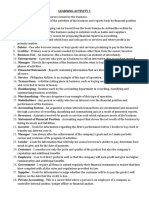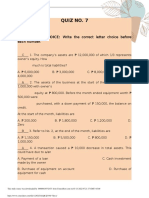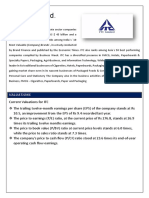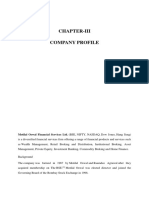0 ratings0% found this document useful (0 votes)
169 viewsAccount Titles and Its Elements
Account Titles and Its Elements
Uploaded by
Jeb PampliegaThe document defines key accounting titles used to classify assets, liabilities, owner's equity, income, and expenses. Assets include cash, accounts receivable, inventory, property, and equipment. Liabilities include accounts payable, taxes payable, and salaries payable. Owner's equity consists of owner's capital contributions and withdrawals. Income sources are services, rent, interest, and commissions. Expenses cover salaries, taxes, supplies, rent, and depreciation.
Copyright:
© All Rights Reserved
Available Formats
Download as PDF, TXT or read online from Scribd
Account Titles and Its Elements
Account Titles and Its Elements
Uploaded by
Jeb Pampliega0 ratings0% found this document useful (0 votes)
169 views3 pagesThe document defines key accounting titles used to classify assets, liabilities, owner's equity, income, and expenses. Assets include cash, accounts receivable, inventory, property, and equipment. Liabilities include accounts payable, taxes payable, and salaries payable. Owner's equity consists of owner's capital contributions and withdrawals. Income sources are services, rent, interest, and commissions. Expenses cover salaries, taxes, supplies, rent, and depreciation.
Original Title
Account Titles and its Elements
Copyright
© © All Rights Reserved
Available Formats
PDF, TXT or read online from Scribd
Share this document
Did you find this document useful?
Is this content inappropriate?
The document defines key accounting titles used to classify assets, liabilities, owner's equity, income, and expenses. Assets include cash, accounts receivable, inventory, property, and equipment. Liabilities include accounts payable, taxes payable, and salaries payable. Owner's equity consists of owner's capital contributions and withdrawals. Income sources are services, rent, interest, and commissions. Expenses cover salaries, taxes, supplies, rent, and depreciation.
Copyright:
© All Rights Reserved
Available Formats
Download as PDF, TXT or read online from Scribd
Download as pdf or txt
0 ratings0% found this document useful (0 votes)
169 views3 pagesAccount Titles and Its Elements
Account Titles and Its Elements
Uploaded by
Jeb PampliegaThe document defines key accounting titles used to classify assets, liabilities, owner's equity, income, and expenses. Assets include cash, accounts receivable, inventory, property, and equipment. Liabilities include accounts payable, taxes payable, and salaries payable. Owner's equity consists of owner's capital contributions and withdrawals. Income sources are services, rent, interest, and commissions. Expenses cover salaries, taxes, supplies, rent, and depreciation.
Copyright:
© All Rights Reserved
Available Formats
Download as PDF, TXT or read online from Scribd
Download as pdf or txt
You are on page 1of 3
Account Titles
Assets are things of value owned by the business and recorded in
terms of their monetary value.
o Cash: currency on hand and money in banks under the name
of the company.
o Accounts Receivable: amounts or claims from clients or
customers resulting from services rendered by the company or
by sale of merchandise.
o Notes Receivable: amounts or claim from clients or customers
which are expressed in writing like promissory notes.
o Interest Receivable: interest is already earned but has not
been collected.
o Merchandise Inventory: goods or merchandise on hand and
available for sale.
o Office Supplies: refer to supplies for office use.
o Store Supplies: supplies for store use
o Prepaid Expenses: advance payments for certain services.
This is considered as a mixed account for it shares values
that of an asset and expense account.
o Land: ground area used in the operation of the business
o Building: structure used or occupied by the business
o Office Equipment: equipment for office use such as
typewriters, calculators, and computers
o Store Equipment: equipment for store use such as weighing
scales, cash registers, freezers used by the business
o Furniture and Fixture: cabinets, tables, chairs, and light
fixtures in the building.
o Accumulated Depreciation- <asset>: a contra-asset account
that aids in determining the net worth of business’ assets.
Liabilities are debts or financial obligations of the business which
usually must be paid on a specific date.
o Accounts Payable: amounts owed to creditors for purchase of
goods or services received.
o Notes Payable: amounts expressed in written promise to pay
the creditor on a specified date.
o Taxes Payable: amounts due to the government like sales
taxes
and income taxes.
o Interest Payable: interest already incurred but has not yet been
paid.
o Rent Payable: rent already used but has not been paid.
o Salaries Payable: employees’ amounts for services done but
has
not yet been paid
o Unearned Income: amounts received in advance before
services
are rendered.
Owner’s Equity refer to the owner’s interest in the business which
consists of the invested capital and results of operations whether
gained or lost. The two equity tiles are:
o <owner’s name>, Capital: amounts of contributions of the
owner to the business.
o <owner’s name>, Drawing: amounts withdrawn by the owner
from the assets of the business for personal use.
Income refers to the different services rendered to customers over a
given accounting period.
The following are some examples of Income:
o Service Income/ Service Fees: refers to services rendered to
customers.
o Interest Income: refers to interest earned whether received in
advance or as realized and/or not yet received.
o Rent Income refers to services of offering office space for
clients.
o Commission Income: refers to services done
through commission or percentages.
Expenses are the different cost rendered for the different use of a
certain services offered to the business.
o Salaries Expense: refers to compensation or remunerations in
whatever form to employees.
o Taxes Expense: refers to taxes and licenses due to the
government.
o Utilities Expense: refers to the cost of electricity and water used
in the ordinary course of business.
o Advertising Expense: pertains to the cost which promotes
certain services and product of the business.
o Rent Expense: cost of the use of office space in each period
o Depreciation Expense: allocated cost of fixed assets in a
current period.
o Interest Expense: interest that has already been considered in
a period.
o (Office/Store) Supplies Expense: things to be
considered if supplies have been used up.
You might also like
- Transaction Analysis-Trial Balance - City LaundryDocument4 pagesTransaction Analysis-Trial Balance - City LaundryJasmine Acta100% (1)
- Problem 15Document1 pageProblem 15Alyssa Jane G. AlvarezNo ratings yet
- Total: Nancy Mulles Data Encoders May 15 2018Document6 pagesTotal: Nancy Mulles Data Encoders May 15 2018Tashnim AreejNo ratings yet
- Journalizing To Adjusting Entries QuizDocument3 pagesJournalizing To Adjusting Entries QuizNemar Jay Capitania100% (1)
- Basic Accounting ModelDocument3 pagesBasic Accounting Modeldlinds2X1No ratings yet
- ACFAR ReviewDocument39 pagesACFAR ReviewYza IgartaNo ratings yet
- This Study Resource Was: Week 4-5 Ulob Lets Check Activity 1Document3 pagesThis Study Resource Was: Week 4-5 Ulob Lets Check Activity 1Merdwindelle AllagonesNo ratings yet
- HomeworkDocument16 pagesHomeworkZaida RectoNo ratings yet
- Seat Work 02 - DingcongDocument3 pagesSeat Work 02 - DingcongJheilson S. DingcongNo ratings yet
- Ulo Week 4-5Document10 pagesUlo Week 4-5Nicolas ArsagaNo ratings yet
- Activity/Assignment #2 - Financial Models - Comparative DataDocument5 pagesActivity/Assignment #2 - Financial Models - Comparative DataNazzer NacuspagNo ratings yet
- Zausa - Chan Accounting FirmDocument50 pagesZausa - Chan Accounting FirmMA. SUSANA ZAUSANo ratings yet
- The Accounting Equation and The Double-Entry SystemDocument24 pagesThe Accounting Equation and The Double-Entry SystemJohn Mark MaligaligNo ratings yet
- Accounting Chapter 4Document44 pagesAccounting Chapter 4PATRICIA COLINANo ratings yet
- Accounting Chapter 5Document42 pagesAccounting Chapter 5Joy PacotNo ratings yet
- Accounting ReviewerDocument21 pagesAccounting ReviewerAdriya Ley PangilinanNo ratings yet
- Recording Transactions in A Financial Transaction WorksheetDocument1 pageRecording Transactions in A Financial Transaction WorksheetSHENo ratings yet
- BAC 1 Lesson8CompletingtheAccountingProcessforaServiceBusiness PDFDocument21 pagesBAC 1 Lesson8CompletingtheAccountingProcessforaServiceBusiness PDFAndwaeNo ratings yet
- Accounting 101Document17 pagesAccounting 101Jenne Santiago BabantoNo ratings yet
- Special JournalDocument7 pagesSpecial JournalJohn Christopher Sta AnaNo ratings yet
- 5th Activity Reyes Laundry ShopDocument17 pages5th Activity Reyes Laundry Shoprain suansing100% (1)
- BFAR ReviewerDocument11 pagesBFAR Reviewergyurijoss.ulfindo.cvtNo ratings yet
- Adjusting Entries Notes CompressDocument7 pagesAdjusting Entries Notes CompressJason YulinaNo ratings yet
- Worksheet PreparationDocument3 pagesWorksheet PreparationJon PangilinanNo ratings yet
- Adjusting Entries and Reversing Entries: Arden Trading DECEMBER 31, 2015Document10 pagesAdjusting Entries and Reversing Entries: Arden Trading DECEMBER 31, 2015John Carlo LorenzoNo ratings yet
- Journalizing Merchandising TransactionsDocument3 pagesJournalizing Merchandising TransactionsMarian Augelio PolancoNo ratings yet
- Lecture 3 Accounting CycleDocument8 pagesLecture 3 Accounting Cycleedith carbonelNo ratings yet
- Holy Cross of Davao College: Other Campuses: Camudmud (IGACOS), Bajada (SOS Drive)Document3 pagesHoly Cross of Davao College: Other Campuses: Camudmud (IGACOS), Bajada (SOS Drive)Haries Vi Traboc Micolob100% (1)
- Mr. Addams' EditingDocument15 pagesMr. Addams' EditingKim KoalaNo ratings yet
- Lit em Ap Chapter 5Document39 pagesLit em Ap Chapter 5Anne ClarisseNo ratings yet
- Quiz No. 7: A. MULTIPLE CHOICE: Write The Correct Letter Choice BeforeDocument6 pagesQuiz No. 7: A. MULTIPLE CHOICE: Write The Correct Letter Choice BeforeJOHN MITCHELL GALLARDONo ratings yet
- S. Roces Answer To Journal EntryDocument4 pagesS. Roces Answer To Journal EntryChoco LebbyNo ratings yet
- LESSON 10 Business TransactionsDocument8 pagesLESSON 10 Business TransactionsUnamadable UnleomarableNo ratings yet
- General Journal, GeveraDocument2 pagesGeneral Journal, GeveraFeiya LiuNo ratings yet
- Lecture Notes - Chapter 7Document17 pagesLecture Notes - Chapter 7Nova Grace LatinaNo ratings yet
- Understated or OverstatedDocument1 pageUnderstated or OverstatedJaimee CruzNo ratings yet
- S. Roces (Closing)Document11 pagesS. Roces (Closing)Jesseric RomeroNo ratings yet
- Lesson 1 ExtendDocument6 pagesLesson 1 ExtendRoel Cababao50% (2)
- Acctg SHDocument12 pagesAcctg SHFiel Zechariah AennaNo ratings yet
- Midterm Summative Examination (B-FND003) (ECO11 & ENR11) - Set A (Answers, Jan Marwin G. Alindog)Document6 pagesMidterm Summative Examination (B-FND003) (ECO11 & ENR11) - Set A (Answers, Jan Marwin G. Alindog)Vaseline QtipsNo ratings yet
- ANSWER KEY Adjustments Quiz 2Document6 pagesANSWER KEY Adjustments Quiz 2Christine Mae BurgosNo ratings yet
- Adjusting Entries Prob 3 4Document4 pagesAdjusting Entries Prob 3 4Jasmine ActaNo ratings yet
- Week 4 5 ULOc Lets Analyze Activities SolutionDocument3 pagesWeek 4 5 ULOc Lets Analyze Activities Solutionemem resuentoNo ratings yet
- Catherine AnswerDocument20 pagesCatherine AnswerJhon Laster QuiñonesNo ratings yet
- Republic of The Philippines ISO 9001:2015 CERTIFIED: Prepared By: GERLY S. RADAM/instructor RALYN T. JAGUROS/instructorDocument7 pagesRepublic of The Philippines ISO 9001:2015 CERTIFIED: Prepared By: GERLY S. RADAM/instructor RALYN T. JAGUROS/instructorJessie Mark AnapadaNo ratings yet
- Merchandising Problem AnswerDocument2 pagesMerchandising Problem AnswerBrian Gerome MercadoNo ratings yet
- Chapter 3 - Effect of Omitting Adjusting Journal Entries: Examples: Type Effect of Not Making The Adjustment DEDocument3 pagesChapter 3 - Effect of Omitting Adjusting Journal Entries: Examples: Type Effect of Not Making The Adjustment DEGelle PascualNo ratings yet
- Activity 2-1 Labausa Catering (Answer)Document13 pagesActivity 2-1 Labausa Catering (Answer)Vince EspinoNo ratings yet
- Journal EntryDocument15 pagesJournal EntryNajOh Marie D ENo ratings yet
- General Ledger - Adrianne, Mendoza-BSBA-1 BLK BDocument6 pagesGeneral Ledger - Adrianne, Mendoza-BSBA-1 BLK BJaks ExplorerNo ratings yet
- ACC 1 Quiz No. 14 Answer KeyDocument9 pagesACC 1 Quiz No. 14 Answer Keynicole bancoroNo ratings yet
- Castro-Merchandising 20211124 0001Document2 pagesCastro-Merchandising 20211124 0001Chelsea Tengco100% (1)
- Practice Question Chapter 4Document17 pagesPractice Question Chapter 4nekochannnnNo ratings yet
- Mr. Addams' Financial StatementDocument10 pagesMr. Addams' Financial StatementKim KoalaNo ratings yet
- Accounting 1Document16 pagesAccounting 1Rommel Angelo AgacitaNo ratings yet
- Performance 2Document1 pagePerformance 2Kaye VillaflorNo ratings yet
- Financial Accounting Concept Assignment 2023Document15 pagesFinancial Accounting Concept Assignment 2023harmanchahalNo ratings yet
- Accounting Problem 16Document1 pageAccounting Problem 16sabbyveraNo ratings yet
- ACCOUNTING IDENTITY-means That TheDocument23 pagesACCOUNTING IDENTITY-means That TheHel LoNo ratings yet
- Journalizing: The Writing Process: "The Book of Original Entries."Document3 pagesJournalizing: The Writing Process: "The Book of Original Entries."Jeb PampliegaNo ratings yet
- Second Quarter Handout Bread and Pastry ProductionDocument8 pagesSecond Quarter Handout Bread and Pastry ProductionJeb PampliegaNo ratings yet
- Rules of Normal Balances (UPDATED)Document9 pagesRules of Normal Balances (UPDATED)Jeb PampliegaNo ratings yet
- Technology and Livelihood Education 9: Fourth Quarter Handout Food and Beverage ServicesDocument8 pagesTechnology and Livelihood Education 9: Fourth Quarter Handout Food and Beverage ServicesJeb PampliegaNo ratings yet
- Lembar Kerja Salon CantikDocument23 pagesLembar Kerja Salon CantikIndra gunawanNo ratings yet
- Marubeni Corporation v. Commissioner of Internal Revenue, G.R. No. 76573, 14 September 1989Document27 pagesMarubeni Corporation v. Commissioner of Internal Revenue, G.R. No. 76573, 14 September 1989Shiela MarieNo ratings yet
- Coleman Technologies CaseDocument2 pagesColeman Technologies Casechandel08No ratings yet
- Stock Ananlysis Worksheet: Stock Symbol Price Shares TotalDocument4 pagesStock Ananlysis Worksheet: Stock Symbol Price Shares Totalsteand sebasNo ratings yet
- Corportae Finance - Term Paper: XXX XXX XXX XXX XXX Maximum Minimum Mean SD CVDocument3 pagesCorportae Finance - Term Paper: XXX XXX XXX XXX XXX Maximum Minimum Mean SD CVAkanksha RoyNo ratings yet
- C C CCC C CCCCCCCC CDocument45 pagesC C CCC C CCCCCCCC Cdevraj537853No ratings yet
- FAC3764 - Assessment 10Document10 pagesFAC3764 - Assessment 10matsheporobertsNo ratings yet
- 1 Questionnaire Conceptual FrameworkDocument9 pages1 Questionnaire Conceptual Frameworkreagan blaireNo ratings yet
- Chapter 16Document23 pagesChapter 16Tanveer AhmedNo ratings yet
- Merger Acquisition CADocument24 pagesMerger Acquisition CAYogesh NeupaneNo ratings yet
- Share Khan BrochureDocument30 pagesShare Khan BrochuremhussainNo ratings yet
- Solman Chap10 Shareholders Equity - CompressDocument18 pagesSolman Chap10 Shareholders Equity - CompressDump DumpNo ratings yet
- Harmish Business ProfileDocument8 pagesHarmish Business Profilearmenia.harshdoshiNo ratings yet
- C21 - MFRS 120 Acct For Gov GrantsDocument14 pagesC21 - MFRS 120 Acct For Gov GrantsMasya IlyanaNo ratings yet
- Issue of Equity Shares Syllabus:: Call in Advance/ Calls in Arrears, Forfeiture and Re Issue of Forfeited SharesDocument8 pagesIssue of Equity Shares Syllabus:: Call in Advance/ Calls in Arrears, Forfeiture and Re Issue of Forfeited SharesMubin Shaikh NooruNo ratings yet
- Tottenham Case SolutionDocument14 pagesTottenham Case SolutionVivek SinghNo ratings yet
- Case Submission On: Mellon Financial and The Bank of New YorkDocument3 pagesCase Submission On: Mellon Financial and The Bank of New Yorkneelakanta srikarNo ratings yet
- Itc LTD: ValuationsDocument11 pagesItc LTD: ValuationsMera Birthday 2021No ratings yet
- Accounting CycleDocument2 pagesAccounting CycleDNLNo ratings yet
- Appointment and Qualification OF Directors: Presentation BY Ca. Anil SharmaDocument52 pagesAppointment and Qualification OF Directors: Presentation BY Ca. Anil SharmaMenuka SiwaNo ratings yet
- Get Release ConfirmationDocument1 pageGet Release ConfirmationJobin JamesNo ratings yet
- Commissioner Vs ManningDocument2 pagesCommissioner Vs ManningLudy Jane FelicianoNo ratings yet
- Date (2019) Transactions: Submitted By: Apple Kris Y. Patulilic Jannah Lei B. Abao Juvem Karyme G. SilvaDocument7 pagesDate (2019) Transactions: Submitted By: Apple Kris Y. Patulilic Jannah Lei B. Abao Juvem Karyme G. SilvaMA RI AHNo ratings yet
- Current RatioDocument8 pagesCurrent RatioShreya ChakrabortyNo ratings yet
- Characterstics of Financial MarketsDocument15 pagesCharacterstics of Financial MarketsbhavyaNo ratings yet
- Oppstar - Prospectus (Part 2)Document204 pagesOppstar - Prospectus (Part 2)kokueiNo ratings yet
- Winding Up and Dissolution of LLPDocument4 pagesWinding Up and Dissolution of LLPAndroid BoyNo ratings yet
- HLL-BBLIL Merger - A Case of Insider TradingDocument14 pagesHLL-BBLIL Merger - A Case of Insider TradingmbacallingNo ratings yet
- Audit of LiabilitiesDocument62 pagesAudit of LiabilitiesだみNo ratings yet
- Chapter-Iii Company Profile: Motilal Oswal Financial Services Ltd. (BSE, NIFTY, NASDAQ, Dow Jones, Hang Seng)Document8 pagesChapter-Iii Company Profile: Motilal Oswal Financial Services Ltd. (BSE, NIFTY, NASDAQ, Dow Jones, Hang Seng)MubeenNo ratings yet





























































































